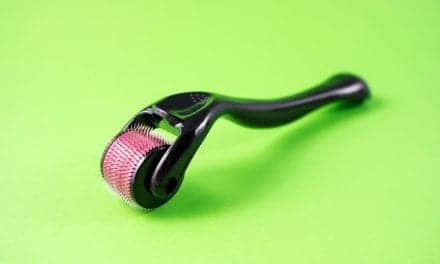A new procedure enables surgeons to perform an upper blepharoplasty and browplasty less invasively

A new technique, however, offers a possible solution to both of those concerns. Using a small, three-tined bioabsorbable implant, surgeons can correct brow ptosis and upper-lid tissue laxity by performing a combination upper blepharoplasty–browplasty using a single upper-lid incision.
The procedure involves the use of a bioabsorbable implant composed of a copolymer made from 82% l–lactide and 18% glycolide. The implant consists of an anchoring post and a fixation platform with three small tines. When implanted, the post is anchored to the frontal bone and the tines engage the periosteum and soft tissue of the brow.

|
The procedure does not require the use of an endoscope or general anesthesia. Instead, it is performed under local anesthesia with medically assisted sedation, which reduces the overall risk. It may be used whenever a patient desires a brow lift in which the soft tissue can be anchored over the brow bone.
Browplasty usually poses a significant challenge as to where to hide the incision, unless it is made behind the hairline. Among the benefits of the upper blepharoplasty–browplasty technique is that the incision is hidden in the first eyelid fold.
The procedure is an ideal option for women who want to subtlely elevate their brow as well as elevate their upper lids. It is beneficial for men as well, because by the time most men want the excess skin removed from their upper lids, their brows—which are generally heavier than women’s—have come down as well.
The challenge to performing an upper blepharoplasty on men is often that the brows are so close to the lash margin that by removing skin between the brows and the lash margin, the brows are pulled closer to the lash margin, narrowing that cleft rather than opening it. It is also difficult to perform forehead lifts on men who have receding hairlines, because the incisions cannot be made at the front of the scalp. This problem is eliminated by the combination upper blepharoplasty–browplasty.
Among the contraindications for the combination procedure are situations in which internal fixation is otherwise contraindicated, such as patients with infections; very thin bones (which might imply an inadequate cranial thickness for the drill bit); thin, atrophic scalps; or allergies or foreign-body sensitivities to plastic biomaterials. Also, some patients require more of a brow lift than this procedure offers, either through preference or necessity—in these cases, a forehead lift would be more appropriate.
Whereas patients will not get as much elevation of the brow with this procedure as they would through a formal forehead lift, the upper blepharoplasty–browplasty does give a very subtle, natural look, which is a key benefit of the procedure.
Preoperative Considerations
The preoperative period entails routine procedures, including evaluating the patient’s needs and wants, and then deciding whether this surgery is appropriate. If it is, a routine workup is conducted.
Patients usually receive an ophthalmology consultation prior to surgery. Patients should be instructed not to take aspirin 2 to 3 weeks prior to surgery, a routine preoperative instruction.
Marking and Incisions
The procedure is performed under monitored anesthesia care; the surgeon administers the local anesthetic. The instruments required for the surgery are routine, including a blepharoplasty set, periosteal elevators, and a drill.
Before performing the surgery, complete the markings usually made for blepharoplasty procedures by using your finger to elevate the brow slightly, approximating how far up you estimate the brow will be after the procedure. While holding that elevation, mark the upper-lid blepharoplasty excision.
Make the upper-lid incision about 8 mm above the lash margin in men and about 9 or 10 mm above the margin in women. Above that, mark the quantity of skin you think you can excise safely.
Inject the patient with 2% lidocaine with epinephrine, using 10 mL of the solution mixed with 0.4 mL of hyaluronidase, which allows the solution to infiltrate farther into the tissues. I usually inject the patient in two places on the upper lid where the incision will be made—the supraorbital nerves where they exit the orbital foramin, and the lateral forehead, just above the brow—using a total of about 5 mL on each side. After making the injection, I run my finger over the tissues to massage the solution into them.
To minimize bleeding, I wait about 10 minutes for the vasoconstrictor to take effect, then excise the premarked skin of the upper eyelid using a pinch technique. Once the skin is excised, elevate superiorly beneath the orbicularis oculi muscle, dissecting down to the supraorbital rim.

Drilling and Implanting
Once you have that exposure, use a Desmarres retractor to elevate the soft tissues, exposing the bone above the orbital rim. Mark the frontal bone 1.0 to 1.2 cm above the orbital rim in a vertical line with the lateral limbus of the eye—this is where you will drill the anchoring hole.
Have the assistant vigorously pull the retractor superiorly, then drill the hole in the premarked spot. The drill bit designed for this procedure has a stop on it so that it will penetrate only 3.0 mm into the cranial bone (Figure 2, page 62). By design, the hole is drilled slightly smaller than the post on the implant so that the device will fit snugly. Drill very carefully; if the hole is made too large, the device will not stay in place and you will have to drill another hole elsewhere.
It is very important that the device’s post be at least 1 cm above the orbital rim. With the post in place, the tines are another 2 mm above that. Make sure that the post is at the bottom and the tines are at the top; it is very easy to place the device upside down.
The implant must be inserted into the anchoring hole until it snaps into place and lies flush against the frontal bone (Figure 3, page 62). Once the device is situated in the anchoring hole, elevate the soft tissues to engage them on the device (Figure 4, page 62).

Once you have the edge of the periosteum above the tines, affix the soft tissues over the tines by pressing firmly into the bone. Significant force is often required to engage the device fully. Check both sides for symmetry. I usually close using a 6-0 polypropylene running suture until I get out to the lateral 1.5 cm of the incision, where I make it into a running locking suture. No dressings are required. The entire surgery takes approximately 1 hour.
Postoperative instructions are similar to postblepharoplasty instructions, except that patients must be told not to manipulate their brow. They must be careful not to rub, hit, or bump their forehead, or do anything else that might knock the periosteal edge off of the implant. Patients should be careful of this for a few weeks after surgery.
The good news is that patients should notice the results immediately.
Side Effects
Side effects can include swelling, which will subside in about 7 to 10 days postsurgery, and bruising, which may take about 2 to 3 weeks to resolve completely. About 1 week after surgery, patients may apply makeup to their bruises if they wish.
|
It is very important to lift the edge of the periosteum above the three tines. This will probably be the most difficult maneuver of the procedure. |
Patients may report palpability and sensitivity over the device until it begins to absorb. This may include a heavy sensation in the upper eyelids for about 1 week or a slight twinge of the tine—for instance, when they look up or move their eyes—as the muscle contracts on the tine. This sensation is nothing more than a mild annoyance, however.
Patients are seen 2 to 3 days after the operation, then another 2 to 3 days later to have the stitches removed. Within 2 months, the periosteum should be firmly fixed in its new position. The tine will disappear within 6 to 12 months as it is absorbed into the body. PSP
Ferdinand F. Becker, MD, FACS, is a facial plastic surgeon in private practice at the Advanced Facial Cosmetic & Laser Surgery Center in Vero Beach, Fla. He holds staff privileges at Indian River Memorial Hospital in Vero Beach, and is a clinical assistant professor at the University of Florida College of Medicine in Gainesville. He can be reached at (772) 234-3700 or [email protected].
Acknowledgment
The author would like to acknowledge Sterling Baker, MD, Oklahoma City, Okla, for teaching him how to perform this surgery.






